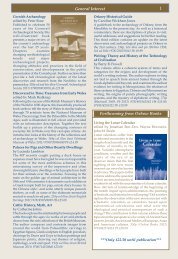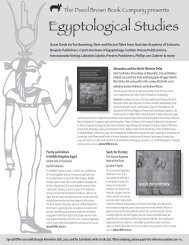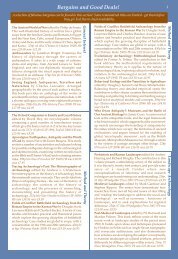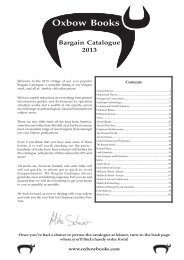New Distributed Titles Fall 2009 - Oxbow Books
New Distributed Titles Fall 2009 - Oxbow Books
New Distributed Titles Fall 2009 - Oxbow Books
Create successful ePaper yourself
Turn your PDF publications into a flip-book with our unique Google optimized e-Paper software.
american archaeology<br />
Gallinazo<br />
An Early Cultural Tradition on the Peruvian North Coast<br />
edited by Jean-François Millaire and Magali Morlion<br />
Over the last decades, considerable effort<br />
has been directed towards the study of<br />
early complex societies of northern Peru<br />
and the art and archaeology of the Moche,<br />
Lambayeque and Chimú societies. Yet, comparatively<br />
little attention has been paid to the<br />
earlier cultural foundations of north coast<br />
civilization: the Gallinazo. This volume is the<br />
result of a round table, which gathered international<br />
scholars to discuss the Gallinazo<br />
phenomenon. Fourteen chapters reconsider<br />
the nature of the Gallinazo culture and its<br />
position within north-coast cultural history,<br />
while addressing wider issues about the development<br />
of complex societies in this area<br />
and within the Andean region in general.<br />
300p, Cotsen Institute of Archaeology, November <strong>2009</strong>, Cotsen Monographs 66.<br />
paperback, 9781931745758, $55.00; hardback, 9781931745741, $95.00(s)<br />
12<br />
The Technology of Maya Civilization<br />
Political Economy and Beyond in Lithic Studies<br />
by Zachary X Hruby, Geoffrey E Braswell<br />
and Oswaldo Chinchilla Mazariegos<br />
The ancient Maya shaped their world with stone tools. Lithic artifacts<br />
helped create the cityscape, were central to warfare and hunting,<br />
were key to craft activities, were used to process food, and were employed<br />
in ritual performance. This volume expands our understanding<br />
of the past by considering Maya lithic artifacts made of chert,<br />
obsidian, silicified limestone, and jade. Using these as sources of data,<br />
lithic specialists examine the relationship between ancient people<br />
and natural resources, and ask questions regarding social organization and political economy. The editors<br />
bring together a detailed, comprehensive view of Maya stone artifacts that is crafted from new research,<br />
progressive analytical methods, and innovative anthropological theory. Thought-provoking introductions<br />
and conclusions contextualize the past thirty years of research on Maya stone tools and look to the future<br />
of the field. Particular emphasis is given not to lithic technology, but to lithic systems as a technology of<br />
civilization. Case studies based on original data collected at archaeological sites in Guatemala, Mexico,<br />
Belize, and Honduras form the bulk of the volume. Limitations presented by the availability of resources,<br />
the social context of production, the control of technology and esoteric knowledge, and political economy<br />
are key issues addressed by the contributors.<br />
288p, 58 illus, hardback, 9781845535087, $100.00, Equinox Publishing, December <strong>2009</strong>,<br />
Approaches to Anthropological Archaeology.<br />
Talking Artifacts<br />
The Twentieth-Century Legacy<br />
by Stanley South<br />
Researchers are becoming<br />
increasingly interested in<br />
understanding the behaviors<br />
and processes representative<br />
of the recent<br />
past. This book provides<br />
an illustration, analysis,<br />
and pattern recognition<br />
of the artifact legacy of a<br />
twentieth century middle-class<br />
American family.<br />
Historical archaeologists,<br />
historians, and museum curators and exhibit designers will find this<br />
book and the author’s Household Artifact Pattern useful in furthering<br />
their understanding of the role played by artifacts in the cultural processes<br />
at work in the past century.<br />
c. 330p, paperback, 9780979773143, $49.50(s),<br />
Eliot Werner Publications, October <strong>2009</strong>.<br />
The David Brown Book Company – <strong>Fall</strong> <strong>2009</strong>

















